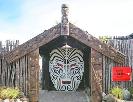One of the main tourist areas in the central North Island is the Lakes District. We visited Lake Taupo while we were in Turangi (the Huka Falls are in Taupo), and this weekend we ventured to Lake Rotorua, which is about a 2-hour drive from Otorohanga.
Mushrooms on toast is a Kiwi fave brekkie and I indulged at a cafe on our way into town. I loved the addition of avocado. In New Zealand (and everywhere?) the general rule is that streaky bacon makes everything better, but I prefer avocado, especially the NZ-grown variety. R had a pulled pork concoction that he reports was very delish, but he doesn't like it when I take pictures of his food, so you'll have to imagine it.
Our primary destination in Rotorua is a thermal area the Maori call Tikitere. The writer George Bernard Shaw visited the area in the 1900s and told his Maori guides that this must be the gate to hell that his theologian friends refer to in their sermons. The name stuck and in English it is became known as Hell's Gate. It's not a scary as the hell I imagine, but it's pretty weird.
 |
| The entrance to the park, a "Waharoa" or carved gateway that depicts the ancestral chief of the Rangiteaorere tribe and the Maori god of volcanic activity, "Ruaumoko." |
 |
| At the entrance visitors meet by Wai Ora, the guardian warrior. |
 |
| We had barely crossed through the entrance before we encountered our first steaming site. In fact, there was steam rising between the paving stones, too. |
Approximately 10,000 years ago the lake that covered this area receded and to this day steam, gases, and hot fluids bubble to the surface. The heat source is 1.5-2 km blow the surface (the other thermal reserves in the Rotorua area have their heat source 10 km or more below the surface).
The footpath through the park steps away from the hot pools for a bit to wander into the bush. The green trees and lush ferns are a welcome break from the harsh landscape of the steaming rocks.
Just a few hundred meters down the path we encountered Kakahi Falls, the largest hot waterfall in the Southern Hemisphere. The water temperature is 40˚C (104˚F). This was a traditional post-war bathing place for Maori warriors, who in addition to certainly enjoying the warm water, benefitted from the healing properties of the sulphur in the water. The entire place is pretty sulphur-stinky, by the way. But you get used to it fairly quick!
The path that leads away from the falls goes to another region of geothermal activity, the Sulphur Crystal Valley. There are black spots resulting from spontaneous combustion of the sulphur deposits. We didn't see any spontaneous combustion explosions during our visit.
 |
| In person these formations are bright yellow and sparkly. |
 |
| They call this Devil's Cauldron. The black mud reaches 120˚C (248˚F). |
 |
| Visitors are allowed to put their hands into this lake (38˚C or 100˚F) to feel the softness of the sulphur water. |
 |
| The water in this pool was bubbling like mad! |
 |
| If you are keen, you can order a traditional Maori lunch cooked in this pool. The sign says an adult pig can be cooked in the pool in about 2 hours. |
We also tried our hands at some carving.
 |
| Our carving instructor. |
 |
| Sweet as, bro! |
We also took advantage of the mud footsoak in the park. The mud was fine, soft, and warm.
From the footsoak we moved on to the full-on spa. The open-air change room was really (and unexpectedly) nice, especially on a day with weather as fine as ours.
 |
| Gayle in the thermal sulphur spa. |
We had a nice long chat following our spa with one of the workers who is Californian. He is taking a break from nursing school and working in NZ for a couple of months. We had a good time comparing Kiwi slang notes. "Sweet as!" "Good on you!" "Cheers, bro!" "That's the one!"
Rotorua's city centre was winding down with the daylight when we rolled into town, so we walked around a bit, peeked in some souvenir shops, had dinner in an awesome Venezuelan restaurant called Sabroso, and called it a day.























































No comments:
Post a Comment